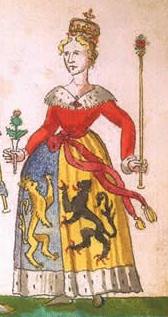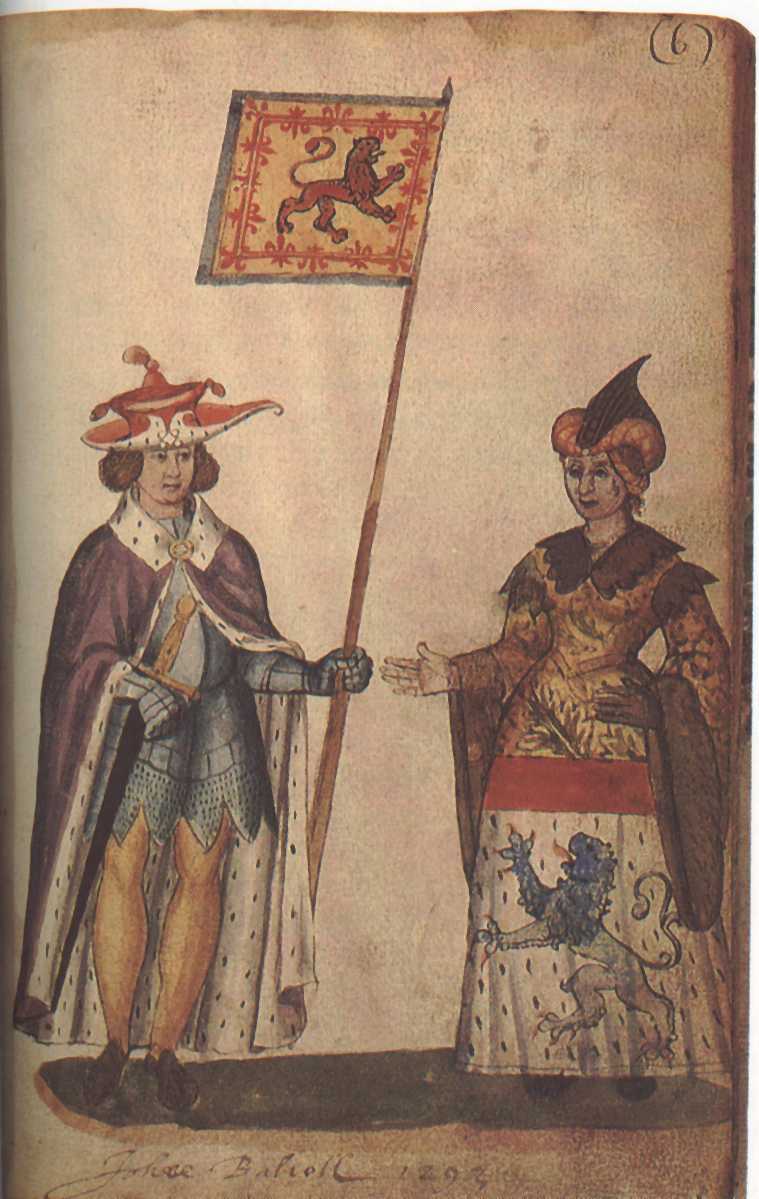|
James II Of Scotland
James II (16 October 1430 – 3 August 1460) was King of Scots from 1437 until his death in 1460. The eldest surviving son of James I of Scotland, he succeeded to the Scottish throne at the age of six, following the assassination of his father. The first Scottish monarch not to be crowned at Scone, James II's coronation took place at Holyrood Abbey in March 1437. After a reign characterised by struggles to maintain control of his kingdom, he was killed by an exploding cannon at Roxburgh Castle in 1460. Life James was born in Holyrood Abbey. He was the son of King James I and Joan Beaufort. By his first birthday, his only brother, his older twin, Alexander, had died, thus leaving James as heir apparent with the title Duke of Rothesay. On 21 February 1437, James I was assassinated, and the six-year-old James immediately succeeded him as James II. He was crowned in Holyrood Abbey by Abbot Patrick on 25 March 1437. On 3 July 1449, the eighteen-year-old James married t ... [...More Info...] [...Related Items...] OR: [Wikipedia] [Google] [Baidu] |
List Of Scottish Monarchs
The monarch of Scotland was the head of state of the Kingdom of Scotland. According to tradition, Kenneth I MacAlpin () was the founder and first King of the Kingdom of Scotland (although he never held the title historically, being King of the Picts instead). The List of kings of the Picts, Kingdom of the Picts just became known as the Kingdom of Alba in Scottish Gaelic, which later became known in Scots language, Scots and English as ''Scotland''; the terms are retained in both languages to this day. By the late 11th century at the very latest, Scottish kings were using the term , or King of Scots, to refer to themselves in Latin. The Kingdom of Scotland was merged with the Kingdom of England to form a single Kingdom of Great Britain in 1707. Thus, Anne, Queen of Great Britain, Queen Anne became the last monarch of the ancient kingdoms of Scotland and England and the first of Great Britain, although the kingdoms had shared a monarch since 1603 (see Union of the Crowns). Her un ... [...More Info...] [...Related Items...] OR: [Wikipedia] [Google] [Baidu] |
Roxburghshire
Roxburghshire or the County of Roxburgh () is a historic county and registration county in the Southern Uplands of Scotland. It borders Dumfriesshire to the west, Selkirkshire and Midlothian to the northwest, and Berwickshire to the north. To the southwest it borders Cumberland and to the southeast Northumberland, both in England. It was named after the Royal Burgh of Roxburgh, a town which declined markedly in the 15th century and is no longer in existence. Latterly, the county town of Roxburghshire was Jedburgh. The county has much the same area as Teviotdale, the basin drained by the River Teviot and tributaries, together with the adjacent stretch of the Tweed into which it flows. The term is often treated as synonymous with Roxburghshire, but may omit Liddesdale as Liddel Water drains to the west coast.Ordnance Gazetteer of Scotland, by, Francis Groome, publ. 2nd edition 1896. Article on Roxburghshire History The county appears to have originated in the 12th centu ... [...More Info...] [...Related Items...] OR: [Wikipedia] [Google] [Baidu] |
William Turnbull (bishop)
William Turnbull (died 3 September 1454) was a Scottish politician and bishop, credited with founding Jedburgh Grammar School and the University of Glasgow. He served as the Bishop of Glasgow from 1448 to 1454 and was the first Chancellor of the University of Glasgow. Biography He came from Bedrule in the Scottish Borders, where a plaque in the local church is erected in his memory. He studied arts at the University of St Andrews (1419), canon law at the University of Leuven, and went on to study at the University of Pavia, Italy, for a doctorate in canon law (1439). Upon his return to Scotland, he befriended King James II and became Keeper of the Privy Seal (1440–1448) and ''Royal Secretary'' (1441–1442). In 1447 he was appointed Bishop of Dunkeld, then a year later Bishop of Glasgow which he held until his death in 1454. On 28 October 1447, John Pigott, the manorial lord, presented Ven William Turnbull, "Bishop of Dunkeld," to the Rectory of Abington Pigotts, in the ... [...More Info...] [...Related Items...] OR: [Wikipedia] [Google] [Baidu] |
University Of Glasgow
The University of Glasgow (abbreviated as ''Glas.'' in Post-nominal letters, post-nominals; ) is a Public university, public research university in Glasgow, Scotland. Founded by papal bull in , it is the List of oldest universities in continuous operation, fourth-oldest university in the English-speaking world and one of Scotland's four Ancient universities of Scotland, ancient universities. Along with the universities of University of St Andrews, St Andrews, University of Aberdeen, Aberdeen, and University of Edinburgh, Edinburgh, the university was part of the Scottish Enlightenment during the 18th century. Glasgow is the List of universities in Scotland, second largest university in Scotland by total enrolment and -largest in the United Kingdom. In common with universities of the pre-modern era, Glasgow originally educated students primarily from wealthy backgrounds; however, it became a pioneer in British higher education in the 19th century by also providing for the needs o ... [...More Info...] [...Related Items...] OR: [Wikipedia] [Google] [Baidu] |
Birthmark
A birthmark is a congenital, benign irregularity on the skin which is present at birth or appears shortly after birth—usually in the first month. Birthmarks can occur anywhere on the skin. They are caused by overgrowth of blood vessels, melanocytes, smooth muscle, fat, fibroblasts, or keratinocytes. Dermatologists divide birthmarks into two types: pigmented birthmarks and vascular birthmarks. Pigmented birthmarks caused by excess skin pigment cells include: moles, café au lait spots, and Mongolian spots. Vascular birthmarks, also called red birthmarks, are caused by increased blood vessels and include macular stains (salmon patches), hemangiomas, and port-wine stains. A little over 1 in 10 babies have a vascular birthmark present by age 1. Several birthmark types are part of the group of skin lesions known as nevi or naevi, which is Latin for "birthmarks". Birthmarks occur as a result of a localized imbalance in factors controlling the development and migration of skin ... [...More Info...] [...Related Items...] OR: [Wikipedia] [Google] [Baidu] |
Kingdom Of Scotland
The Kingdom of Scotland was a sovereign state in northwest Europe, traditionally said to have been founded in 843. Its territories expanded and shrank, but it came to occupy the northern third of the island of Great Britain, sharing a Anglo-Scottish border, land border to the south with the Kingdom of England. During the Middle Ages, Scotland engaged in intermittent conflict with England, most prominently the Wars of Scottish Independence, which saw the Scots assert their independence from the English. Following the annexation of the Hebrides and the Northern Isles from Norway in 1266 and 1472 respectively, and the capture of Berwick upon Tweed, Berwick by England in 1482, the territory of the Kingdom of Scotland corresponded to that of modern-day Scotland, bounded by the North Sea to the east, the Atlantic Ocean to the north and west, and the North Channel (British Isles), North Channel and Irish Sea to the southwest. In 1603, James VI of Scotland became King of England, joini ... [...More Info...] [...Related Items...] OR: [Wikipedia] [Google] [Baidu] |
Flanders
Flanders ( or ; ) is the Dutch language, Dutch-speaking northern portion of Belgium and one of the communities, regions and language areas of Belgium. However, there are several overlapping definitions, including ones related to culture, language, politics, and history, and sometimes involving neighbouring countries. The demonym associated with Flanders is Flemings, Fleming, while the corresponding adjective is Flemish people, Flemish, which can also refer to the collective of Dutch dialects spoken in that area, or more generally the Belgian variant of Standard Dutch. Most Flemings live within the Flemish Region, which is a federal state within Belgium with its own elected government. However, like Belgium itself, the official capital of Flanders is the City of Brussels, which lies within the Brussels, Brussels-Capital Region, not the Flemish Region, and the majority of residents there are French speaking. The powers of the Flemish Government in Brussels are limited mainly ... [...More Info...] [...Related Items...] OR: [Wikipedia] [Google] [Baidu] |
Catherine Of Cleves (1417–1479)
Catherine of Cleves (25 May 1417 – 10 February 1479) was Duchess of Guelders by marriage to Arnold, Duke of Guelders. She acted as regent of Guelders during the absence of her spouse in 1450. The Hours of Catherine of Cleves was commissioned for her. Life Catherine was the daughter of Adolph I, Duke of Cleves and Marie of Burgundy. She was a niece of Philip the Good. Duchess and regent Catherine lived with her parents until 1431, despite already having been married the year before. She had close ties with Philip of Burgundy, who was mistrusted by her husband. Catherine had her daughter Mary raised at the Burgundian court. When her husband punished Driel, he lost support in his duchy. Catherine acted as intermediate between her husband and the Estates of the realm. In 1450, Duke Arnold went on a pilgrimage to Rome and Palestine. During his absence, Catherine acted as regent. She supported her son Adolf when he took over power from his father. Charles, Duke of Burgundy had ... [...More Info...] [...Related Items...] OR: [Wikipedia] [Google] [Baidu] |
Arnold, Duke Of Guelders
Arnold of Egmond (14 July 1410 – 23 February 1473) was Duke of Guelders, Count of Zutphen. Life Arnold was born in Egmond-Binnen, North Holland, the son of John II of Egmond and Maria van Arkel. On 11 July 1423, Arnold, still a boy, succeeded Duke Reinald IV. Arnold was the grandson of Reinald's sister, Johanna. Although the Emperor Sigismund had invested the Duke of Berg with the duchy of Gelders, Arnold retained the confidence of the Estates by enlarging their privileges, and enjoyed the support of Duke Philip of Burgundy. Arnold was betrothed, and afterwards united in marriage to Catherine of Cleves, a niece of Philip of Burgundy. Subsequently, however, Duke Arnold fell out with his ally as to the succession to the see of Utrecht, whereupon Philip joined with the four chief towns of Guelders in the successful attempt of Arnold's son Adolf to substitute his own for his father's authority. Arnold gave up his claim on Jülich only after his defeat in 1444 by Gerh ... [...More Info...] [...Related Items...] OR: [Wikipedia] [Google] [Baidu] |
Duke Of Rothesay
Duke of Rothesay ( ; ; ) is the main dynastic title traditionally given to the male heir apparent to the Scottish and, later, British thrones. The dukedom was created in 1398 by Robert III of Scotland for his eldest son. Duke of Rothesay is the title mandated for use by the heir apparent when in Scotland, in preference to the titles ''Prince of Wales'' and ''Duke of Cornwall'', which are used in the rest of the United Kingdom and overseas. The title is named after Rothesay on the Isle of Bute, but is not associated with any legal entity or landed property. The Duke of Rothesay also holds other Scottish titles, including Earl of Carrick, Baron of Renfrew, Lord of the Isles, and Prince and Great Steward of Scotland. The current holder of the title is William, Prince of Wales, and his wife, Catherine, is the current Duchess of Rothesay. History David Stewart, Duke of Rothesay, the son of Robert III of Scotland, first held the dukedom from its creation in 1398. After his ... [...More Info...] [...Related Items...] OR: [Wikipedia] [Google] [Baidu] |
Heir Apparent
An heir apparent is a person who is first in the order of succession and cannot be displaced from inheriting by the birth of another person. A person who is first in the current order of succession but could be displaced by the birth of a more eligible heir is known as an heir presumptive. Today these terms most commonly describe heirs to hereditary titles (e.g. titles of nobility) or offices, especially when only inheritable by a single person. Most monarchies refer to the heir apparent of their thrones with the descriptive term of ''crown prince'' or ''crown princess'', but they may also be accorded with a more specific substantive title: such as Prince of Orange in the Netherlands, Duke of Brabant in Belgium, Prince of Asturias in Spain (also granted to heirs presumptive), or the Prince of Wales in England and Wales; former titles include Dauphin in the Kingdom of France, and Tsesarevich in Imperial Russia. The term is also applied metaphorically to an expected succe ... [...More Info...] [...Related Items...] OR: [Wikipedia] [Google] [Baidu] |
Alexander Stewart, Duke Of Rothesay
Alexander Stewart, Duke of Rothesay (16 October 1430 – 16 October 1430) was the eldest of a pair of twins. He died in infancy, and his younger twin brother became James II of Scotland. The twins were born in Holyrood Palace, Edinburgh. The title Duke of Rothesay is the honour taken by the heir apparent to the Scottish throne, and so it was given to this boy, the fifth child but first son of James I of Scotland and Joan Beaufort. Ancestry References {{DEFAULTSORT:Rothesay, Alexander Stewart, Duke of 1430 births 1430 deaths 15th-century Scottish people Scottish royalty Scottish princes Alexander Alexander Alexander () is a male name of Greek origin. The most prominent bearer of the name is Alexander the Great, the king of the Ancient Greek kingdom of Macedonia who created one of the largest empires in ancient history. Variants listed here ar ... Dukes of Rothesay Princes and great stewards of Scotland 15th-century Scottish peers Scottish heirs appare ... [...More Info...] [...Related Items...] OR: [Wikipedia] [Google] [Baidu] |





